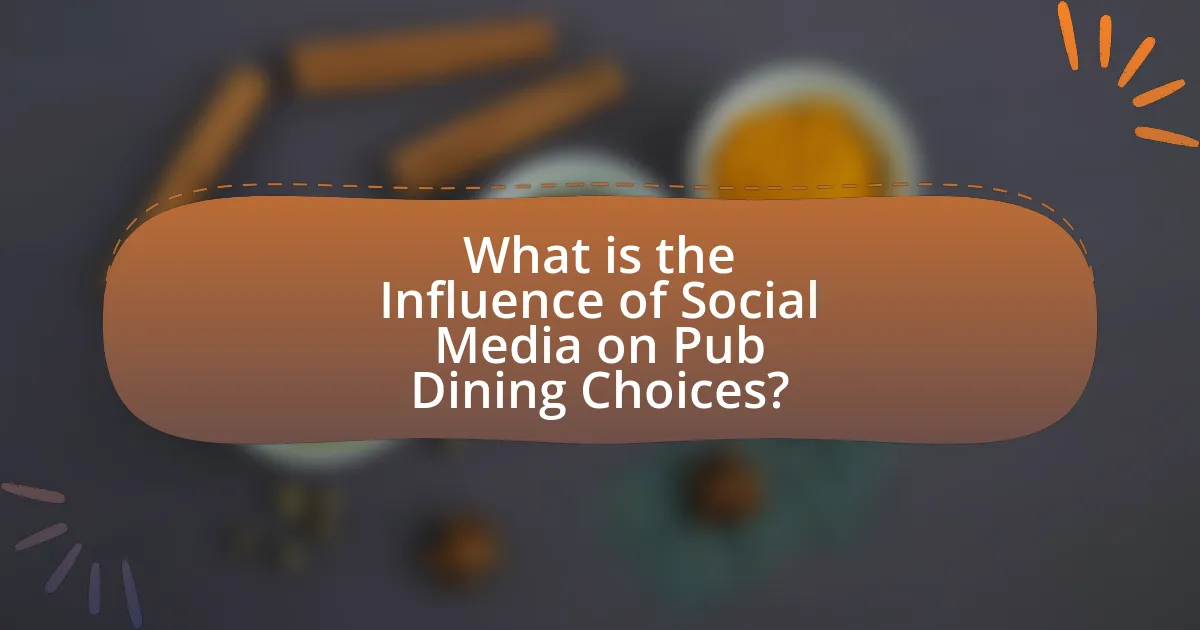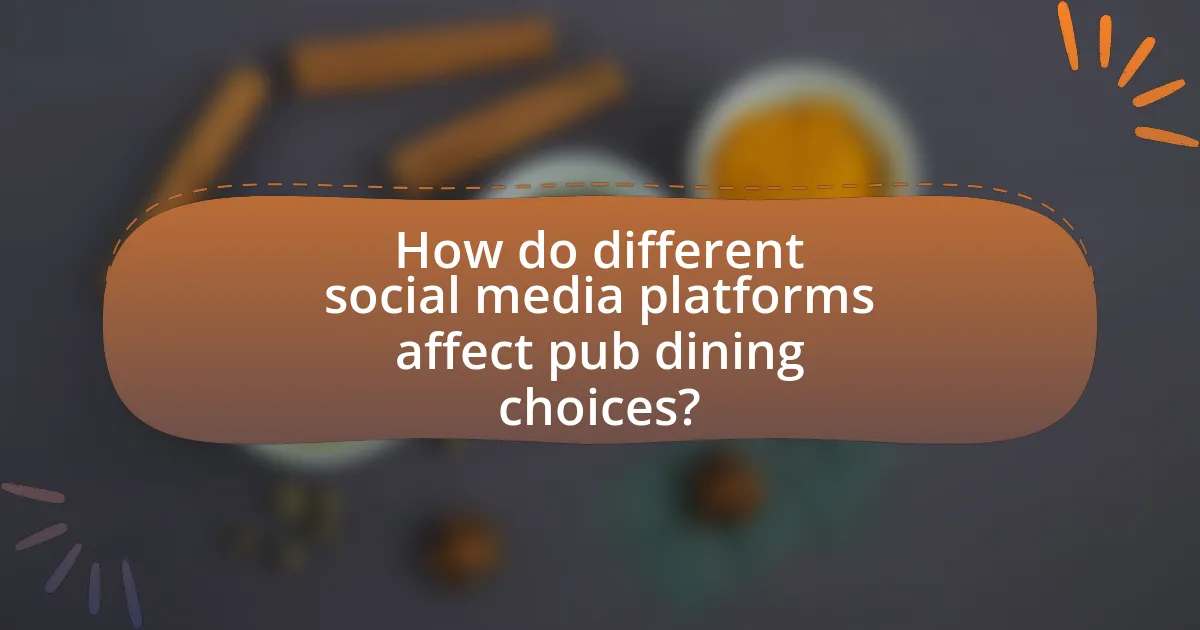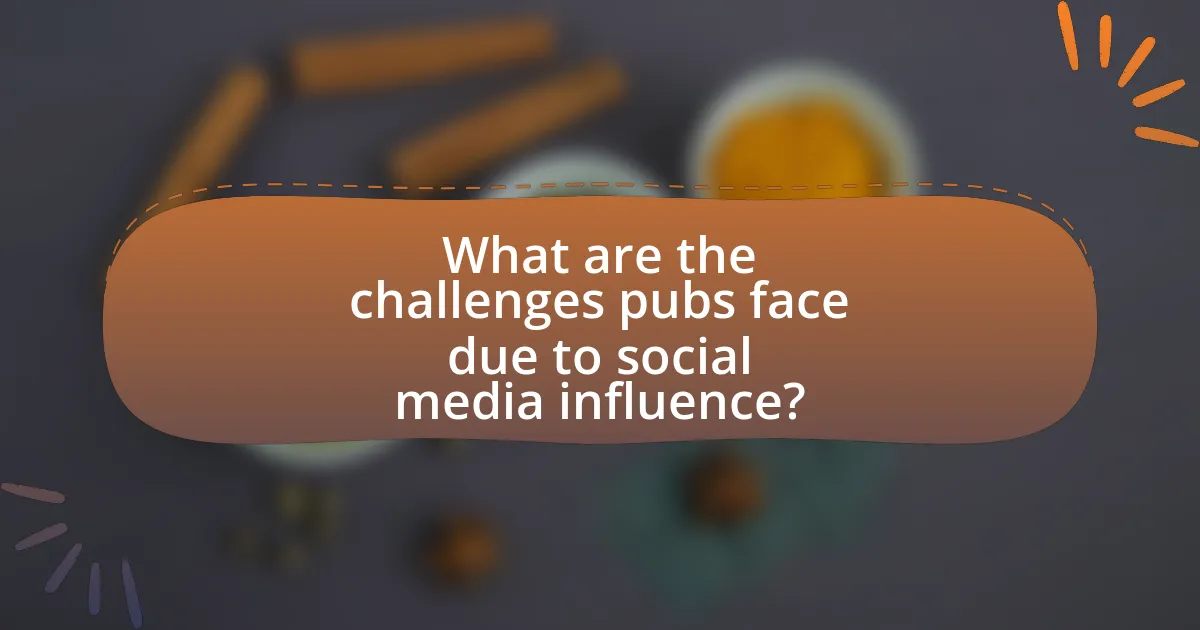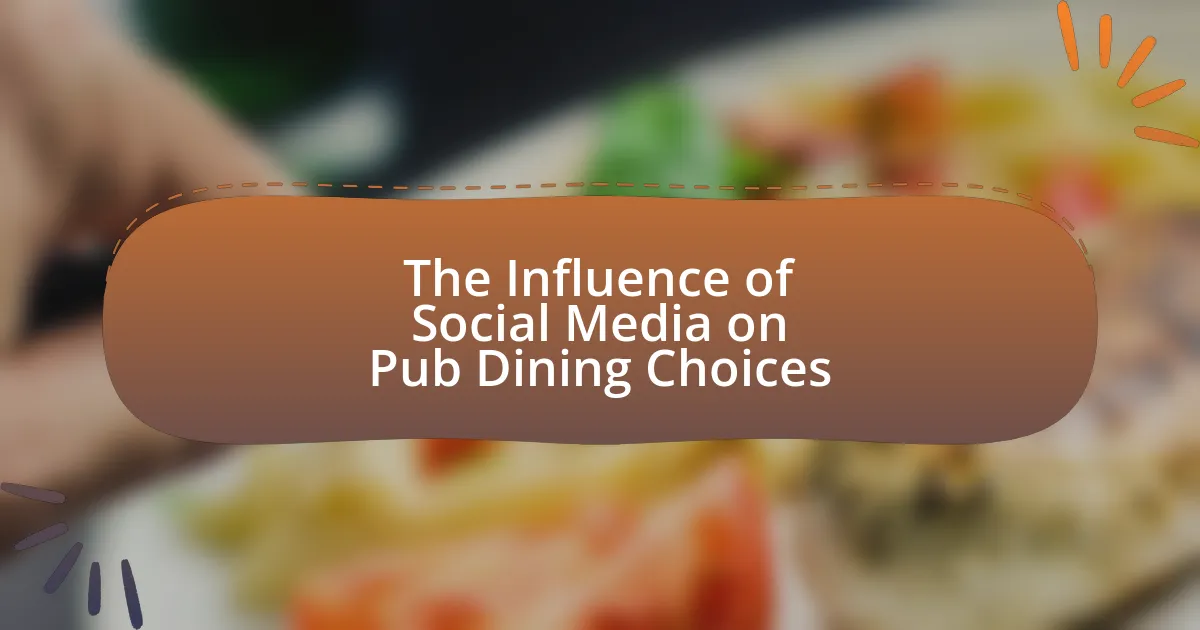The article examines the significant influence of social media on pub dining choices, highlighting how platforms like Instagram and Facebook shape consumer perceptions and preferences. It discusses the role of user-generated content and online reviews in enhancing visibility and attracting customers, particularly among younger demographics such as Millennials and Gen Z. Key strategies for pubs include leveraging visually appealing content, engaging with patrons, and managing online feedback to foster customer loyalty. Additionally, the article addresses emerging trends in pub dining driven by social media, as well as the challenges and risks associated with maintaining an active online presence.

What is the Influence of Social Media on Pub Dining Choices?
Social media significantly influences pub dining choices by shaping consumer perceptions and preferences. Platforms like Instagram and Facebook allow users to share their dining experiences, showcasing food presentations and ambiance, which can attract potential customers. A study by the Journal of Hospitality and Tourism Technology found that 70% of millennials are influenced by social media when choosing dining options, highlighting the importance of online presence for pubs. Additionally, user-generated content often serves as authentic endorsements, making social media a powerful tool for pubs to enhance visibility and appeal to a broader audience.
How does social media shape consumer preferences in pub dining?
Social media significantly shapes consumer preferences in pub dining by influencing perceptions, promoting trends, and facilitating peer recommendations. Platforms like Instagram and Facebook allow users to share experiences, photos, and reviews, which can enhance the visibility of specific pubs and their offerings. For instance, a study by the Journal of Hospitality and Tourism Technology found that 70% of consumers are influenced by social media when choosing dining options, highlighting the power of visual content and user-generated reviews in shaping preferences. Additionally, social media campaigns and influencer partnerships can create buzz around new menu items or events, further driving consumer interest and foot traffic to pubs.
What role do online reviews play in influencing dining decisions?
Online reviews significantly influence dining decisions by shaping consumer perceptions and expectations. Research indicates that approximately 90% of consumers read online reviews before visiting a restaurant, highlighting their importance in the decision-making process. Positive reviews can enhance a restaurant’s reputation and attract more customers, while negative reviews can deter potential diners. Additionally, a study published in the Journal of Marketing Research found that a one-star increase in a restaurant’s Yelp rating can lead to a 5-9% increase in revenue, demonstrating the direct financial impact of online reviews on dining choices.
How do social media platforms affect the visibility of pubs?
Social media platforms significantly enhance the visibility of pubs by allowing them to reach a broader audience through targeted advertising and user-generated content. For instance, platforms like Instagram and Facebook enable pubs to showcase their ambiance, menu items, and events, attracting potential customers who may not have discovered them otherwise. According to a study by the Pew Research Center, 69% of adults in the U.S. use social media, which indicates a vast potential audience for pubs to engage with. Additionally, user-generated content, such as reviews and photos shared by patrons, can create organic visibility and credibility, influencing others’ dining choices. This dynamic interaction on social media platforms ultimately drives foot traffic and increases brand awareness for pubs.
Why is social media important for pubs in attracting customers?
Social media is important for pubs in attracting customers because it enhances visibility and engagement with potential patrons. By utilizing platforms like Facebook, Instagram, and Twitter, pubs can showcase their offerings, promote events, and interact directly with their audience. Research indicates that 54% of social media users utilize these platforms to research dining options, highlighting the critical role social media plays in influencing consumer choices. Furthermore, user-generated content, such as reviews and photos, can significantly impact a pub’s reputation and draw in new customers, as 79% of consumers trust online reviews as much as personal recommendations.
What are the key social media strategies used by pubs?
Pubs utilize several key social media strategies to enhance their visibility and engage customers. These strategies include creating visually appealing content, promoting events and special offers, and engaging with customers through interactive posts. For instance, pubs often share high-quality images of food and drinks to attract attention, as studies show that posts with images receive 94% more views than text-only posts. Additionally, hosting events such as trivia nights or live music and promoting them on platforms like Facebook and Instagram helps to drive foot traffic. Engaging with customers through comments and direct messages fosters a sense of community and loyalty, which is crucial for repeat business.
How does social media engagement impact customer loyalty?
Social media engagement significantly enhances customer loyalty by fostering a sense of community and connection between brands and consumers. When businesses actively engage with customers on platforms like Facebook, Instagram, and Twitter, they create opportunities for direct interaction, feedback, and personalized experiences. Research indicates that 71% of consumers who have a positive social media experience with a brand are likely to recommend it to others, demonstrating the correlation between engagement and loyalty. Furthermore, brands that respond to customer inquiries and comments on social media can increase customer satisfaction, which is a critical factor in building long-term loyalty.
What trends are emerging in pub dining due to social media influence?
Emerging trends in pub dining due to social media influence include an increased focus on visually appealing food presentations, the rise of themed events, and the integration of user-generated content in marketing strategies. Visually appealing dishes, often referred to as “Instagrammable” meals, attract customers who seek to share their dining experiences online, leading to a 30% increase in foot traffic for establishments that prioritize aesthetics. Themed events, such as trivia nights or seasonal celebrations, are gaining popularity as they encourage social sharing and engagement, enhancing community involvement. Additionally, pubs are leveraging user-generated content by featuring customer photos and reviews on their social media platforms, which has been shown to boost customer trust and engagement by up to 50%.
How are food trends propagated through social media channels?
Food trends are propagated through social media channels primarily by influencers and user-generated content that showcases visually appealing dishes. Influencers, who often have large followings, create engaging posts featuring trendy foods, which encourages their audience to try and share these items. User-generated content, such as photos and reviews from everyday consumers, further amplifies these trends as people seek authentic experiences and recommendations from peers. According to a study published in the Journal of Consumer Research, 79% of consumers reported that user-generated content significantly influences their dining choices, highlighting the power of social media in shaping food trends.
What demographic shifts are observed in pub dining choices influenced by social media?
Demographic shifts in pub dining choices influenced by social media include an increase in younger consumers, particularly Millennials and Gen Z, who prioritize experiences and social sharing over traditional dining. Research indicates that 60% of Millennials are influenced by social media when choosing dining options, leading to a preference for pubs that offer Instagram-worthy aesthetics and unique menu items. Additionally, there is a notable rise in diverse culinary offerings to cater to the varied tastes of these younger demographics, reflecting their openness to global cuisines as showcased on platforms like Instagram and TikTok.

How do different social media platforms affect pub dining choices?
Different social media platforms significantly influence pub dining choices by shaping consumer perceptions and preferences. For instance, platforms like Instagram and Facebook allow users to share visually appealing images of food and drinks, which can attract potential diners and create a desire to visit specific pubs. Research indicates that 60% of consumers are influenced by social media posts when choosing where to eat, highlighting the power of visual content in decision-making. Additionally, platforms such as Yelp and TripAdvisor provide user-generated reviews and ratings, which directly impact a pub’s reputation and can sway dining choices based on perceived quality and service.
What unique features of platforms like Instagram and Facebook influence dining decisions?
Platforms like Instagram and Facebook influence dining decisions through visual content sharing, user-generated reviews, and targeted advertising. The visual nature of Instagram allows users to post appealing food images, which can create cravings and inspire dining choices; studies show that 30% of millennials choose restaurants based on Instagram photos. Facebook facilitates community engagement through reviews and recommendations, where 79% of users trust peer reviews over traditional advertising. Additionally, targeted ads on both platforms can reach specific demographics, increasing the likelihood of attracting potential diners based on their interests and behaviors.
How does visual content on Instagram impact customer attraction to pubs?
Visual content on Instagram significantly enhances customer attraction to pubs by showcasing the ambiance, food, and drink offerings in an appealing manner. High-quality images and videos create a visual narrative that entices potential customers, making them more likely to visit. Research indicates that 60% of Instagram users discover new products through the platform, and 75% of users take action after being inspired by a post. This suggests that visually engaging content can effectively drive foot traffic to pubs, as it influences dining choices and fosters a desire to experience the depicted atmosphere and offerings firsthand.
What role does Facebook play in community engagement for pubs?
Facebook serves as a vital platform for community engagement for pubs by facilitating direct communication between establishments and their patrons. Pubs utilize Facebook to share events, promotions, and updates, fostering a sense of community and encouraging customer interaction. According to a study by the Pew Research Center, 69% of adults in the U.S. use Facebook, making it an effective tool for reaching a broad audience. Additionally, Facebook’s features, such as event creation and group discussions, allow pubs to engage with local customers, gather feedback, and build loyalty, ultimately enhancing their visibility and customer relationships within the community.
How do user-generated content and hashtags affect pub visibility?
User-generated content and hashtags significantly enhance pub visibility by increasing engagement and reach on social media platforms. When patrons share their experiences through photos, reviews, or posts, they create authentic content that attracts potential customers. According to a study by the Pew Research Center, 70% of adults in the U.S. use social media, making it a vital tool for businesses to connect with a broader audience. Hashtags further amplify this effect by categorizing content, making it easier for users to discover relevant posts. For instance, using popular hashtags related to food and dining can lead to higher visibility in search results, driving more traffic to the pub’s social media pages and, ultimately, to the establishment itself.
What are the best practices for pubs to leverage user-generated content?
Pubs can effectively leverage user-generated content by encouraging patrons to share their experiences on social media platforms. This can be achieved through strategies such as creating unique hashtags for events or menu items, incentivizing customers with discounts for sharing photos, and featuring user content on the pub’s official social media pages. Research indicates that 79% of consumers say user-generated content highly impacts their purchasing decisions, highlighting its importance in influencing dining choices. By actively engaging with customers and showcasing their content, pubs can enhance their online presence and attract new visitors.
How do hashtags contribute to the discoverability of pubs on social media?
Hashtags significantly enhance the discoverability of pubs on social media by categorizing content and making it searchable. When users include specific hashtags related to pubs, such as #pubs or #craftbeer, their posts become visible to a broader audience interested in those topics. Research indicates that posts with at least one hashtag receive 12.6% more engagement than those without, according to a study by HubSpot. This increased visibility allows potential customers to find pubs more easily, leading to higher foot traffic and engagement.

What are the challenges pubs face due to social media influence?
Pubs face several challenges due to social media influence, primarily including negative reviews, increased competition, and the pressure to maintain an active online presence. Negative reviews on platforms like Yelp or Google can significantly impact a pub’s reputation, as 84% of people trust online reviews as much as personal recommendations. Increased competition arises from the ease with which new establishments can promote themselves on social media, making it harder for existing pubs to attract customers. Additionally, the pressure to engage with patrons online requires pubs to invest time and resources into social media marketing, which can divert attention from their core operations.
How can negative reviews on social media impact a pub’s reputation?
Negative reviews on social media can significantly harm a pub’s reputation by influencing potential customers’ perceptions and decisions. Research indicates that 79% of consumers trust online reviews as much as personal recommendations, highlighting the weight that negative feedback carries. When a pub receives unfavorable reviews, it can lead to decreased foot traffic, as potential patrons may choose competitors with better ratings. Furthermore, negative reviews can create a lasting impression, as they remain visible and accessible to a wide audience, potentially deterring future customers. This impact is compounded by the viral nature of social media, where a single negative review can quickly spread, amplifying its effect on the pub’s overall image.
What strategies can pubs implement to manage negative feedback online?
Pubs can implement several strategies to manage negative feedback online effectively. First, they should respond promptly and professionally to all negative comments, demonstrating that they value customer feedback and are committed to resolving issues. This approach can help mitigate damage to their reputation, as studies show that timely responses can improve customer perceptions by up to 70%.
Additionally, pubs can encourage satisfied customers to leave positive reviews, which can help balance out negative feedback. Research indicates that businesses with a higher ratio of positive to negative reviews tend to attract more customers.
Furthermore, analyzing feedback trends can provide insights into recurring issues, allowing pubs to make necessary operational improvements. For instance, if multiple reviews mention slow service, addressing this concern can enhance overall customer satisfaction.
Lastly, creating a dedicated online presence, such as a customer service page, can streamline communication and show that the pub is proactive in managing its online reputation. By implementing these strategies, pubs can effectively manage negative feedback and maintain a positive image in the competitive dining landscape.
How does the fast-paced nature of social media create challenges for pubs?
The fast-paced nature of social media creates challenges for pubs by demanding immediate engagement and responsiveness to customer feedback. Pubs must constantly monitor their online presence to address negative reviews or comments quickly, as delays can lead to reputational damage. For instance, a study by the Pew Research Center found that 70% of consumers trust online reviews as much as personal recommendations, highlighting the importance of timely responses. Additionally, the rapid sharing of information can lead to viral trends that pubs must adapt to swiftly, or risk losing relevance in a competitive market.
What are the risks of relying too heavily on social media for customer engagement?
Relying too heavily on social media for customer engagement poses several risks, including diminished personal interaction, potential misinformation, and over-dependence on platform algorithms. Diminished personal interaction can lead to a lack of authentic relationships with customers, as face-to-face communication is often more effective in building loyalty. Potential misinformation can arise from user-generated content, which may misrepresent a brand or product, leading to customer distrust. Over-dependence on platform algorithms can result in reduced visibility for businesses, as changes in algorithms can drastically affect engagement rates, making it difficult for brands to reach their audience consistently. According to a study by the Pew Research Center, 64% of adults believe that social media has a negative impact on their relationships, highlighting the importance of maintaining direct communication channels.
How can pubs balance traditional marketing with social media efforts?
Pubs can balance traditional marketing with social media efforts by integrating both strategies to create a cohesive brand presence. For instance, they can use traditional marketing methods, such as flyers and local newspaper ads, to promote events while simultaneously leveraging social media platforms like Instagram and Facebook to reach a broader audience and engage with customers in real-time. This dual approach allows pubs to attract local patrons through traditional means while also appealing to younger demographics who are more active online. Research indicates that 72% of consumers prefer to engage with brands through social media, highlighting the importance of this channel in modern marketing strategies. By aligning promotional messages across both traditional and digital platforms, pubs can enhance their visibility and customer engagement effectively.
What are the potential pitfalls of social media marketing for pubs?
The potential pitfalls of social media marketing for pubs include negative customer feedback, mismanagement of brand image, and ineffective targeting of audiences. Negative customer feedback can quickly spread on social media platforms, damaging a pub’s reputation if not addressed promptly. Mismanagement of brand image occurs when pubs fail to maintain a consistent voice or message, leading to confusion among customers. Ineffective targeting can result in wasted marketing resources, as ads may reach audiences that are not interested in the pub’s offerings, ultimately reducing engagement and return on investment. According to a study by Sprout Social, 70% of consumers feel more connected to brands with a strong social media presence, highlighting the importance of effective management in social media marketing.
What practical tips can pubs use to enhance their social media presence?
Pubs can enhance their social media presence by consistently posting engaging content that showcases their unique offerings and atmosphere. Regularly sharing high-quality images of food and drinks, promoting special events, and interacting with customers through comments and messages can significantly increase engagement. According to a study by Sprout Social, posts with images receive 650% more engagement than text-only posts, highlighting the importance of visual content. Additionally, utilizing targeted ads can help reach a broader audience, as Facebook reports that 1.62 billion users engage with ads daily. By leveraging these strategies, pubs can effectively boost their visibility and attract more patrons.
How can pubs create engaging content that resonates with their audience?
Pubs can create engaging content that resonates with their audience by leveraging social media platforms to showcase unique experiences, promotions, and community involvement. By sharing high-quality images and videos of food, drinks, and events, pubs can attract attention and encourage sharing among patrons. For instance, a study by the Pew Research Center indicates that 69% of adults use social media, making it a vital tool for reaching potential customers. Additionally, interactive content such as polls, contests, and user-generated content can foster a sense of community and encourage audience participation, enhancing engagement.
What are effective ways for pubs to interact with customers on social media?
Pubs can effectively interact with customers on social media by utilizing engaging content, responding promptly to inquiries, and hosting interactive events. Engaging content includes sharing high-quality images of food and drinks, behind-the-scenes videos, and customer testimonials, which can increase audience engagement by up to 50%. Prompt responses to customer comments and messages foster a sense of community and can enhance customer loyalty, as studies show that 70% of consumers expect a response within an hour. Hosting interactive events, such as live quizzes or polls, encourages participation and can lead to increased foot traffic, as 60% of customers are more likely to visit a pub that actively engages with them online.
